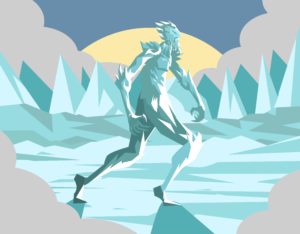
If you’ve watched any Marvel Cinematic Universe films featuring Asgardian characters, you’ve heard about the Frost Giants. They typically wreak havoc with Loki’s help and wage war against Odin, Thor, and the rest of Asgard in the Marvel comics and the MCU. Yet they’re based on Norse mythology about the Jötnar, a race of formidable entities whose relationships with other Scandinavian deities are much more complex. An examination of the Jötnar in ancient Norse stories uncovers some fascinating things.
Etymology Tells Part of the Tale
To clarify, “Jötnar” is the plural form of “jotünn.” The Online Etymology Dictionary explains that the latter may be derived from the Germanic word “ettin” and in turn the Proto-Germanic word “itunoz,” which could possibly translate as “man-eater.” Interestingly, the old Norse giants are also sometimes referred to as “trolls.” The OED mentions the Germanic linguistic roots of the word “troll,” both as a standalone term and as a root word with generic supernatural connotations. One example of this is the Swedish verb “trolla,” which means “to charm or bewitch.”
Three Clans of Formidable Deities
As the New World Encyclopedia divulges, the old Norse classified their deities into three clans:
- Aesir, which included warrior, weather, and sky deities such as Thor and Odin
- Vanir, a tribe of earth and fertility deities that included Freyja and her brother Freyr
- Jötnar, a race of fearsome and powerful supernatural entities
While the Aesir usually called Asgard their home and the Vanir inhabited the pastoral realm of Vanaheim, the Jötnar lived in a wild region called Jotunheim. They trace their origins to Ymir, a primordial giant who spawned their ancestors directly from his own body. Ymir’s body also serves as the primal substance from which the earth, its oceans, and the sky were formed after Odin and his two brothers slew him. Notable figures classified as Jötnar include several famous and lesser-known beings:
- Skaldi, a goddess of hunting, skiing, and winter
- Gerd, the wife of fertility and weather god Freyr
- Loki, a child of two Jötnar and the companion and blood brother of Odin
- Fenrir, a dreadful wolf and son of Loki
Order Versus Chaos, Not Good Versus Evil
Although the Jötnar is one of the three major supernatural clans in Norse mythology, the Aesir and the Vanir coexisted peacefully together while frequently clashing with the Jötnar. At the same time, many Aesir and Vanir also befriended and married jotünn beings. Scholars who have studied Scandinavian texts such as the Poetic Edda emphasize that battles between the Jötnar and the other two clans should not be viewed through the typical moral binarism of “good versus evil.”
Writing for Norse Mythology for Smart People, author Daniel McCoy clarifies that ancient Norse peoples may have seen the Jötnar as mighty devourers, exemplars of destruction, entropy, and decay, who continually attempt to return the world to a state of chaos. The Jötnar were also an integral part of existence itself, representing the principle of chaos coexisting with order in a careful balance to maintain the universe. Ragnarök, a cataclysmic series of events predicted to end our current universe, begins when the Jötnar succeed in attacking and killing many of the Aesir. One of Ragnarök’s chief triggers is when Fenrir escapes from his chains to devour Odin and the sun, according to the Encyclopedia Britannica.
Old Stories Reimaged in New Ways
While Marvel comic and film writers take literary license in reinterpreting ancient Norse tales, their works are exposing modern fans to older narratives. Nevertheless, knowing their original elements helps new audiences better understand these stories. Embodying the untamed and unpredictable forces of nature, the Jötnar played an important role in how Scandinavians from centuries ago tried to make sense of the world around them.

